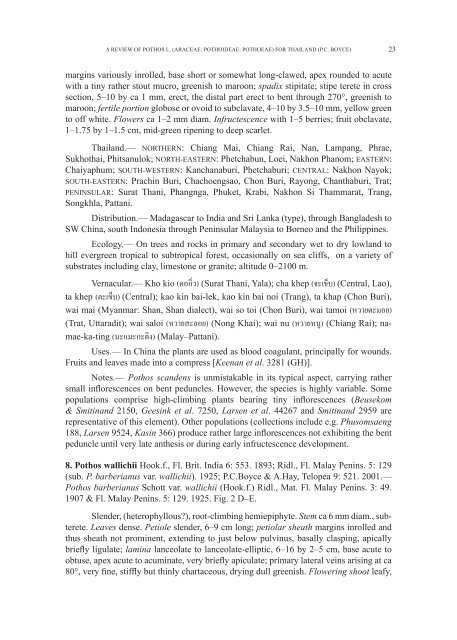Create successful ePaper yourself
Turn your PDF publications into a flip-book with our unique Google optimized e-Paper software.
A REVIEW OF POTHOS L. (ARACEAE: POTHOIDEAE: POTHOEAE) FOR <strong>THAI</strong>LAND (P.C. BOYCE)<br />
margins variously inrolled, base short or somewhat long-clawed, apex rounded to acute<br />
with a tiny rather stout mucro, greenish to maroon; spadix stipitate; stipe terete in cross<br />
section, 5–10 by ca 1 mm, erect, the distal part erect to bent through 270°, greenish to<br />
maroon; fertile portion globose or ovoid to subclavate, 4–10 by 3.5–10 mm, yellow green<br />
to off white. Flowers ca 1–2 mm diam. Infructescence with 1–5 berries; fruit obclavate,<br />
1–1.75 by 1–1.5 cm, mid-green ripening to deep scarlet.<br />
Thailand.— NORTHERN: Chiang Mai, Chiang Rai, Nan, Lampang, Phrae,<br />
Sukhothai, Phitsanulok; NORTH-EASTERN: Phetchabun, Loei, Nakhon Phanom; EASTERN:<br />
Chaiyaphum; SOUTH-WESTERN: Kanchanaburi, Phetchaburi; CENTRAL: Nakhon Nayok;<br />
SOUTH-EASTERN: Prachin Buri, Chachoengsao, Chon Buri, Rayong, Chanthaburi, Trat;<br />
PENINSULAR: Surat Thani, Phangnga, Phuket, Krabi, Nakhon Si Thammarat, Trang,<br />
Songkhla, Pattani.<br />
Distribution.— Madagascar to India and Sri Lanka (type), through Bangladesh to<br />
SW China, south Indonesia through Peninsular Malaysia to Borneo and the Philippines.<br />
Ecology.— On trees and rocks in primary and secondary wet to dry lowland to<br />
hill evergreen tropical to subtropical forest, occasionally on sea cliffs, on a variety of<br />
substrates including clay, limestone or granite; altitude 0–2100 m.<br />
Vernacular.— Kho kio (คอกิ่ว)<br />
(Surat Thani, Yala); cha khep (จะเข็บ) (Central, Lao),<br />
ta khep (ตะเข็บ) (Central); kao kin bai-lek, kao kin bai noi (Trang), ta khap (Chon Buri),<br />
wai mai (Myanmar: Shan, Shan dialect), wai so toi (Chon Buri), wai tamoi (หวายตะมอย)<br />
(Trat, Uttaradit); wai saloi (หวายสะลอย) (Nong Khai); wai nu (หวายหนู) (Chiang Rai); namae-ka-ting<br />
(นะแมะกะติง) (Malay–Pattani).<br />
Uses.— In China the plants are used as blood coagulant, principally for wounds.<br />
Fruits and leaves made into a compress [Keenan et al. 3281 (GH)].<br />
Notes.— Pothos scandens is unmistakable in its typical aspect, carrying rather<br />
small inflorescences on bent peduncles. However, the species is highly variable. Some<br />
populations comprise high-climbing plants bearing tiny inflorescences (Beusekom<br />
& Smitinand 2150, Geesink et al. 7250, Larsen et al. 44267 and Smitinand 2959 are<br />
representative of this element). Other populations (collections include e.g. Phusomsaeng<br />
188, Larsen 9524, Kasin 366) produce rather large inflorescences not exhibiting the bent<br />
peduncle until very late anthesis or during early infructescence development.<br />
8. Pothos wallichii Hook.f., Fl. Brit. India 6: 553. 1893; Ridl., Fl. Malay Penins. 5: 129<br />
(sub. P. barberianus var. wallichii). 1925; P.C.Boyce & A.Hay, Telopea 9: 521. 2001.—<br />
Pothos barberianus Schott var. wallichii (Hook.f.) Ridl., Mat. Fl. Malay Penins. 3: 49.<br />
1907 & Fl. Malay Penins. 5: 129. 1925. Fig. 2 D–E.<br />
Slender, (heterophyllous?), root-climbing hemiepiphyte. Stem ca 6 mm diam., subterete.<br />
Leaves dense. Petiole slender, 6–9 cm long; petiolar sheath margins inrolled and<br />
thus sheath not prominent, extending to just below pulvinus, basally clasping, apically<br />
briefly ligulate; lamina lanceolate to lanceolate-elliptic, 6–16 by 2–5 cm, base acute to<br />
obtuse, apex acute to acuminate, very briefly apiculate; primary lateral veins arising at ca<br />
80°, very fine, stiffly but thinly chartaceous, drying dull greenish. Flowering shoot leafy,<br />
23
















